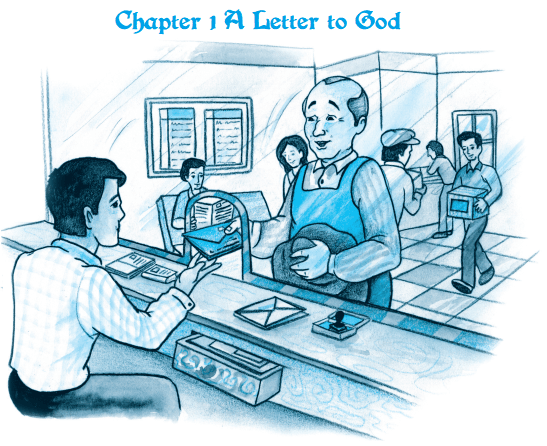Unit 1 - A letter to God Question AnswerFor Class 10 English
Ultimate NCERT Solutions for Unit 1 – A letter to God
Updated Solution 2024-2025 Updated Solution 2024-2025
NCERT Solutions for Class 10 English,
Unit 1 – A letter to God Question Answer, Grammar& comprehension
Unit 1 – A letter to God Question Answer
Let’s begun
Q 1: You have read about Lencho in ‘A Letter to God’, First Flight, textbook in English for Class X. How has the story of Lencho moved you? What do you think about Lencho’s faith in God and his attitude towards the officials in the post office? Do you think he is right in asking God for support and then blaming the people at the post office? Discuss his actions with your friends. Why does he do so?
Ans 1: Lencho was a poor but hardworking farmer. When a heavy hailstorm destroyed his crops, he was devastated. The loss meant his family might starve that year. However, Lencho had deep faith in God and believed only He could save them.
With hope, Lencho wrote a letter to God, asking for financial help. His request showed his innocence and desperation. As a responsible and dedicated farmer, he had put all his effort into his fields. Seeing his hard work ruined in moments was heartbreaking. His love for his family drove him to take this unusual step—writing to an unseen power he trusted completely.
I feel deep sympathy for Lencho. Losing his crops to natural disasters was beyond his control. However, his reaction toward the post office workers was unfair. They were kind enough to collect money to help him, yet he accused them of stealing part of it. Instead of blaming them, he should have been grateful for their generosity.
What do you think—was Lencho justified in his actions, or was he too harsh on the post office staff? Discuss with your friends!
Q 2: The summary of the story of Lencho is given below. The sequence of the story is jumbled up. Read the story again and rearrange the jumbled sentences to make a coherent story
| Write the correct order in numbers in the column below |
Jumbled sentences |
| 1. | But it rained heavily and hailstorm thrashed his corn field and all the corn was destroyed. |
| 2. | He wrote ‘To God’ on the envelope and posted it. |
| 3. | Lencho predicted it will rain and it did. He and his wife were happy. |
| 4. | Lencho felt desperate but believed that God would help him. |
| 5. | Their corn field was longing for water. |
| 6. | The postman and the postmaster laughed at Lencho’s letter but were surprised by the faith of the man. |
| 7. | He wrote a letter to God asking for a hundred pesos to sow his field again and to survive until the next crop came up. |
| 8. | After some days, Lencho went to the post office to receive the money as the postmaster watched him. |
| 9. | He immediately went to the counter and asked for a pen and paper, wrote a few lines and posted the letter. |
| 10. | Lencho, his wife, and their children lived in a lonely house in a valley. |
| 11. | When the postmaster opened the letter, it said “Oh! Thanks for sending the money. But I have received only seventy pesos. Next time you please send the money directly to me. The people at the post office are a bunch of crooks. They have taken the thirty pesos.” |
| 12. | He opened the letter and was happy to find the money. He counted and found it was only seventy pesos. |
| 13. | The postmaster collected about 70 pesos from his colleagues and sent it to Lencho |
Ans 2: The correct sequence of the story A Letter to God with the sentences rearranged in the proper order:
Correct Order:
| Write the correct order in numbers in the column below | Jumbled sentences |
| 10. | Lencho, his wife, and their children lived in a lonely house in a valley. |
| 5. | Their corn field was longing for water |
| 3. | Lencho predicted it will rain and it did. He and his wife were happy. |
| 1. | But it rained heavily and hailstorm thrashed his corn field and all the corn was destroyed. |
| 4. | Lencho felt desperate but believed that God would help him. |
| 7. | He wrote a letter to God asking for a hundred pesos to sow his field again and to survive until the next crop came up. |
| 2. | He wrote ‘To God’ on the envelope and posted it. |
| 6. | The postman and the postmaster laughed at Lencho’s letter but were surprised by the faith of the man. |
| 13. | The postmaster collected about 70 pesos from his colleagues and sent it to Lencho. |
| 8. | After some days, Lencho went to the post office to receive the money as the postmaster watched him. |
| 12. | He opened the letter and was happy to find the money. He counted and found it was only seventy pesos. |
| 9. | He immediately went to the counter and asked for a pen and paper, wrote a few lines and posted the letter. |
| 11. | When the postmaster opened the letter, it said “Oh! Thanks for sending the money. But I have received only seventy pesos. Next time you please send the money directly to me. The people at the post office are a bunch of crooks. They have taken the thirty pesos.” |
Q. Create a graphic description based on the given summary of ‘A Letter to God’.
Ans => Graphic Description of “A Letter to God”
Scene 1: The Lonely House in the Valley
Visual: A small, weathered farmhouse stands isolated in a vast valley. Rolling hills stretch into the distance under a wide sky. Lencho, a humble farmer with a weathered face, gazes at his dry cornfield with concern. His wife and children look on anxiously.

Scene 2: Praying for Rain
Visual: Dark clouds gather as Lencho points to the sky, hopeful. His family watches as the first raindrops fall, their faces lighting up with relief. The land drinks in the water, and green shoots seem to perk up.

Scene 3: The Devastating Hailstorm
Visual: Suddenly, the sky turns violent. Ice pellets the size of marbles pelt down, destroying the crops. Lencho and his family rush inside, watching helplessly as their field is flattened. The once-healthy corn is now a ruined, tangled mess.

Scene 4: Lencho’s Faith in God
Visual: Inside their dimly lit home, Lencho sits at a wooden table, his face determined. He picks up a pen and writes a letter with shaking hands. The camera zooms in on the envelope: “To God” written in rough, earnest handwriting.
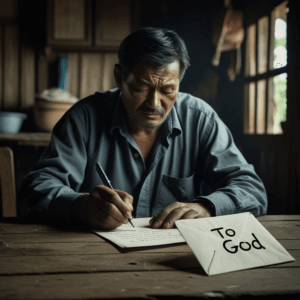
Scene 5: The Post Office’s Reaction
Visual: The postmaster, a middle-aged man with spectacles, reads the letter and bursts into laughter. But his expression softens as he realizes Lencho’s sincerity. He shows it to the postman, who shakes his head in amazement.

Scene 6: The Postmaster’s Kindness
Visual: The postmaster gathers his colleagues, holding out a hat. Coins and bills drop in as they collect money for Lencho. A close-up shows the final amount: 70 pesos—not the full 100 Lencho asked for, but a generous effort.
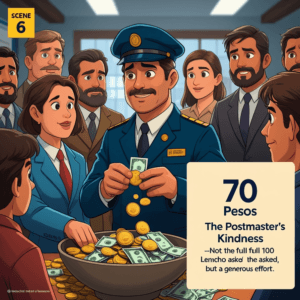
Scene 7: Lencho Receives the Letter
Visual: Lencho walks into the post office, his face hopeful. The postmaster watches discreetly as Lencho opens the envelope. His smile fades as he counts the money—only 70 pesos. His brow furrows in disappointment.

Scene 8: The Angry Letter to God
Visual: Lencho sits at the post office counter, scribbling furiously. The camera shows his words: “The post office employees are crooks—they stole 30 pesos!” He seals the letter and drops it in the mailbox, storming out.
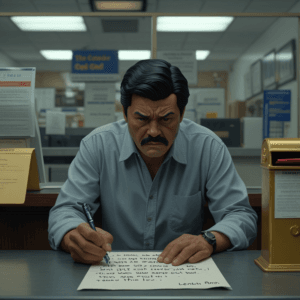
Scene 9: The Postmaster’s Shock
Visual: The postmaster opens Lencho’s second letter. His eyes widen in disbelief as he reads the accusation. The postman peers over his shoulder, and both exchange a look of stunned silence.

Final Image: Faith vs. Reality
Visual: A split screen—on one side, Lencho kneeling in prayer in his ruined field; on the other, the postmaster holding the letter, sighing. The words “Faith can move mountains… but not always human hearts” fade in.

Unit 1 – A letter to God Question Answer for class 10 English
Updated Solution 2024-2025
Reading Comprehension:
Given below is a story of the tailor who has been known for his skills in cheating and stealing. Read in groups of four or in pairs. You may discuss the events and incidences of the story with your friends and write them in a sequential manner.
The Trader and the Tailor
There was a tailor who was known for beating others in the art of being light-fingered and thievery. A trader swore that even with a hundred attempts, the tailor would not be able to take a coil of thread from him without his knowledge.
The trader was told that many others, more intelligent than him, had been beaten by the tailor. They said he should not imagine himself so great, for his ego would only give him worse troubles in competition with the tailor. Still, the trader became more competitive and made a wager that the tailor would not be able to rob him of anything.
He wagered an Arab horse with those who taunted him. If the tailor failed to steal, then they would have to give him a horse instead. That night, the trader lay awake troubled by the situation and could not sleep a wink.
In the morning, he put a piece of satin cloth under his arm and went to the bazaar and entered the shop’ and saluted the cunning rogue warmly. The tailor sprang up from his seat and welcomed the trader, inquiring about his health with cordiality exceeding even that of the trader, planting in his heart great feelings of affection for him. When the trader heard these songs of sweetness from the tailor, he flung down the piece of silk saying, “Cut this into a coat for me and make it wide below my navel so as not to hamper my legs and tight about it to show off my figure.”
The tailor answered, “O! kindly man, I will do you a hundred services,” and accepted the order. He measured the satin and inspected the working surface and all the time chatted away to the trader in idle gossip, about other amirs and of bounties and gifts he had received from them, and about misers and their mean ways, and made the trader laugh with hysterics. During this beguiling talk, he was snipping away with his scissors rapidly, cutting as fast as his lips moved.
The trader was laughing, the tailor was cutting, the trader closed his eyes in joy, the tailor cut extra pieces, tucking them under his thighs, hidden away from all, but God. From his delight at the tailor’s tales, the trader’s former boast went out of his mind. What satin? what boast? What wager? The trader was drunk on the jokes told by the tailor.
Then the tailor told such an incredible story that the trader fell over on his back with laughter. The tailor swiftly stitched a swatch of the satin to the hem of his underpants while the trader was paying no attention at all, greedily sucking with every guffaw, at the jests the tailor told. The tailor continued to tell funnier and funnier tales ‘and jokes until the trader was completely within his power.
With his eyes shut and his reason vanished, the bewildered and boastful trader was drunk with joy. And the tailor continued to cut, filching yet more of the beautiful cloth, with nothing to stop him now. And yet the trader begged for more.
You who becomes the slave of the jest, no story is more laughable than you yourself, think on this at the edge of your grave. How long will you listen to the lies of this world that leave your mind and spirit unhinged? The Universal Tailor will cut and stitch the hems of a hundred traveler’s, silly as children.
Eventually the tailor became bored with the whole story and told the trader that he better leave before another tale was told, “For if I tell another one, the coat will be too tight for you, and you will stop laughing and weep tears of blood.” ……. Rumi (Abridged)
Q 1. Did you enjoy the story of ‘The Trader and the Tailor’? The story is summarised below. Read the story again with your friend and complete the paragraph using short sentences with the given hints.
Once there was a tailor who was known for _____ (cheat, and thievery). He could cheat anyone with his cunning way of deceiving people. A trader challenged that the tailor would not be able to cheat him. He _____ (go) to the tailor with _____ (satin). The tailor _____ (welcome). The trader _____ (please) by the tailor’s praise. He told the tailor to make a coat for him. The tailor _____ (praise) the trader (maximum).
The tears _____ (joy). The tailor, (recount) funny tales and the trader forgot _______(bet). The tailor started snipping _____ and _____(hide). Eyes of the trader _____ (tears and joy) and yet the trader kept on asking for _____ (stories). At last, the tailor told the trader that _____ (tight) and _____(weep-blood).
Ans 1: Once there was a tailor who was known for cheating and thievery. He could cheat anyone with his cunning way of deceiving people. A trader challenged that the tailor would not be able to cheat him. He went to the tailor with a piece of satin. The tailor welcomed him warmly. The trader was pleased by the tailor’s praise. He told the tailor to make a coat for him. The tailor praised the trader excessively. The trader was in tears of joy.
The tailor recounted funny tales, and the trader forgot his bet. The tailor started snipping the cloth and hiding pieces under his thigh. The eyes of the trader were filled with tears and joy, and yet the trader kept on asking for more stories. At last, the tailor told the trader that the coat would be too tight and he would weep tears of blood.
Vocabulary:
Q 1: In this story you have come across a word “light-fingered” which means inclined to steal things. Some such words are given below. Use appropriate words and fill in the blanks.
light-headed, light year, light-hearted, light sleeper, light-duty
(a) The _____ is a unit of distance used to measure distance in space.
(b) The farmer bought a _____ truck to transport their produce, as it uses less diesel.
(C) We had a fairly _____ discussion with our colleagues.
(d) Rita felt dizzy and _____ after skydiving.
(e) He is a _____, a slightest noise wakes him.
Ans 1: Here are the correct answers with the appropriate words filled in the blanks:
(a) The light year is a unit of distance used to measure distance in space.
(b) The farmer bought a light-duty truck to transport their produce, as it uses less diesel.
(c) We had a fairly light-hearted discussion with our colleagues.
(d) Rita felt dizzy and light-headed after skydiving.
(e) He is a light sleeper—the slightest noise wakes him.
Explanation of Each Word:
- Light year – A unit of astronomical distance.
- Light-duty – Designed for less heavy or demanding work.
- Light-hearted – Cheerful and carefree in tone.
- Light-headed – Feeling dizzy or slightly faint.
- Light sleeper – Someone who wakes up easily from sleep.
Grammar:
Q1: You have come across Relative Clauses in the lesson ‘A Letter to God’. Read about the relative clauses again. Complete, the sentences, given below in the table by adding the most suitable clause from the box and make it a relative clause. The first one has been done for you.
Contains meaning of words Stitches clothes Tell lies Won the best actor award this Year Hit a century Is faithful | Need to fill in the Application Is a crook Help themselves Won the Nobel prize Believe in hard work |
(a) A tailor is a person who stitches clothes.
(b) A dictionary is a book _____
(c) The book is about a scientist _____
(d) What is the name of the player _____
(e) I don’t like people _____
(f) What is the name of the actor_____
(g) Students _____ should meet the principal in her office.
(h) Friends of the trader thought the tailor _____ and can cheat anyone.
(j) Lencho _____ thought God would help him.
(j) Those _____ will succeed.
(k) God helps those _____
Ans 1: Here are the completed sentences with the most suitable relative clauses:
(a) A tailor is a person who stitches clothes.
(b) A dictionary is a book that contains the meaning of words.
(c) The book is about a scientist who won the Nobel Prize.
(d) What is the name of the player who hit a century?
(e) I don’t like people who tell lies.
(f) What is the name of the actor who won the best actor award this year?
(g) Students who need to fill in the application should meet the principal in her office.
(h) Friends of the trader thought the tailor who is a crook and can cheat anyone.
(i) Lencho, who is faithful, thought God would help him.
(j) Those who believe in hard work will succeed.
(k) God helps those who help themselves.
Editing:
Q 1: Suppose Lencho gets a hundred pesos in his envelope. He writes a letter to God expressing his gratitude. However, he has missed a word in each line- Help him with those words so that his letter is complete.
Dear God! Thank for | Thank you for |
(a) sending a hundred pesos help | ___________ |
(b) I am very for this kind gesture. | ____________ |
(c) You were my only and your | ____________ |
(d) help has my faith in you. | ____________ |
(e) This money will help me until the crop | ____________ |
(f) and I promise to hard in the future. Sincerely yours, Lencho | ____________ |
Ans 1: Here’s Lencho’s corrected letter with the missing words added:
Dear God!
Thank you for
(a) sending a hundred pesos to help
(b) I am very grateful for this kind gesture.
(c) You were my only hope and your
(d) help has strengthened my faith in you.
(e) This money will help me survive until the crop
(f) and I promise to work hard in the future.
Sincerely yours,
Lencho
Corrections Explained:
- (a) Added “to” → “to help” (infinitive verb form needed).
- (b) Added “grateful” → Completes the emotion (“very grateful”).
- (c) Added “hope” → Logical completion for “only hope” (what Lencho relies on).
- (d) Added “strengthened” → Shows how God’s help deepened his faith.
- (e) Added “survive” → Money’s purpose (to live until the next harvest).
- (f) Added “work” → Verb needed for “promise to work hard.”
Listening:
Q 1: Here is an interesting story. The story has been told in two ways. Story A has all the odd sentences (1,3,5, …) and story B has the even sentences (2,4,6, …). Working in pairs, one of you take up Story A and the other take up Story B.
The person with Story A will read out the first sentence and the partner (person with story B) will write in the space provided. Then the person with Story B will read sentence two and the partner will write in the space for sentence two. Likewise complete the whole story. Once the story is completed, both of you will read out to each other to check whether you have listened carefully to your partner and written the complete story.
Story – A the Race | Story – B The Race |
1) Every evening the animals of the Machlipatti used to sit under the banyan tree. | 1) _________________ . |
Ans 1: Here’s the complete story with both parts filled in correctly:
Story A – The Race
- Every evening the animals of the Machlipatti used to sit under the banyan tree.
- One day Kho-Kho, the rabbit, was feeling bored.
- He said, “Let’s run a race!” “Who will run a race with you?
- No one can run faster than you said Bhalu, the bear, eating a mango.
- Choo-Choo, the rat, shouted, “No, he’s not the fastest runner.
- I can run faster than him.
- Everyone laughed at him.
- Then it was decided to have a race between Kho-Kho and Choo-Choo.
- The starting point was the peepul tree and the finishing point was the neem tree.
- Coocku, the cock, crowed to start the race.
- Kho-Kho and Choo-Choo started running.
- After running half the distance, Kho-Kho looked back but Choo-Choo was nowhere to be seen.
- “He must be far behind.”
- When he was near the finishing point, Choo-Choo jumped over Kho-Kho’s shoulder and touched the neem tree first.
- He shouted, “I’ve won the race! I’ve won the race!”
- Everyone cheered for Choo-Choo.
Story B – The Race
- Every evening the animals of the Machlipatti used to sit under the banyan tree.
- One day Kho-Kho, the rabbit, was feeling bored.
- He said, “Let’s run a race!” “Who will run a race with you?
- No one can run faster than you said Bhalu, the bear, eating a mango.
- Choo-Choo, the rat, shouted, “No, he’s not the fastest runner.
- I can run faster than him.
- Everyone laughed at him.
- Then it was decided to have a race between Kho-Kho and Choo-Choo.
- The starting point was the peepul tree and the finishing point was the neem tree.
- Coocku, the cock, crowed to start the race.
- Kho-Kho and Choo-Choo started running.
- After running half the distance, Kho-Kho looked back but Choo-Choo was nowhere to be seen.
- “He must be far behind.”
- When he was near the finishing point, Choo-Choo jumped over Kho-Kho’s shoulder and touched the neem tree first.
- He shouted, “I’ve won the race! I’ve won the race!”
- Everyone cheered for Choo-Choo.
Activity Guide:
- Work in pairs – one reads Story A (odd sentences), the other Story B (even sentences)
- Take turns reading sentences aloud while partner writes the missing ones
- After completing, read full stories to each other to check accuracy
- Notice how the complete story emerges through collaboration
Key Lesson: The activity demonstrates how listening carefully and working together helps reconstruct complete information – just like how the animals’ teamwork made the race exciting! The clever rat’s victory shows that size doesn’t determine success.
Speaking:
Q 1: Lencho, the main character in the story, is a farmer. He supports his family through farming. The conflict in the story happens when a hailstorm strikes the field and destroys his farm: All the hard work, for nothing! The entire land is wrecked by catastrophe. There is no one who can help. Lencho’s complete faith in God is amazing during the calamity.
So, one type of conflict dominating in the story is man versus nature. Discuss with your partner the natural calamities that play havoc in the lives of people. Collect photographs and make a visual presentation to share in the class.
Ans 1: In “A Letter to God,” the main conflict is between man and nature. Lencho, a poor farmer, depends entirely on his crops for survival. When a hailstorm strikes, it destroys all his hard work. This natural disaster leaves him hopeless and desperate. Despite this, Lencho’s unshakable faith in God stands out. He believes that God will help him recover from the damage.
This kind of conflict – man versus nature – is very common in real life. Natural calamities like floods, droughts, cyclones, earthquakes, wildfires, and landslides often affect the lives of people, especially farmers and those living in rural or coastal areas. These disasters not only destroy homes and livelihoods but also take lives and displace entire communities.
Discussion Ideas (for partner/class activity):
Talk about:
- How floods affect villages and farmlands.
- How droughts lead to famine and migration.
- How wildfires destroy forests, homes, and animal habitats.
- Earthquakes damaging cities and causing loss of life.
Visual Presentation Ideas:
You can create a PowerPoint presentation or poster with photos and short notes on:
- Floods – Houses submerged; people being rescued by boats.
- Drought – Cracked, dry lands; people walking long distances for water.
- Earthquakes – Collapsed buildings and rescue operations.
- Cyclones – Uprooted trees, destroyed homes, high tides.
- Forest Fires – Flames in forests, wildlife fleeing.
📌 Sources for images:
- Government disaster management websites
- News articles (NDTV, The Hindu, BBC)
- Image libraries like Unsplashed, Pixabay (for royalty-free photos)
“Students Do yourself with the help of your partner and teachers”
Q 2: Try writing a small poem on the topic man versus’ nature. Read aloud the poem with the required stress and intonation. Given below is a poem written by Norman Little ford, which may help you think and compose.
Man vs Nature –
The heavens roared with thunder
as lightning filled the skies
was this God getting angry
or Nature’s big surprise.
Is Mother Nature telling us
the best way that she can
to stop the interference
and abuse she gets from man.
We marvel at her beauty
each time we look around
then dig up all her treasures
from their natural burial ground.
We forget that Nature gives us
all that keeps us living
we take it all and still want more
but never think of giving.
We build across the countryside
progressing every day
but Mother Nature can’t progress
for man is in the way. -Norman Little ford
Ans 2: Man vs. Nature
(Inspired by Norman Littleford)
The winds howl wild, the rivers rise,
A tempest tears through peaceful skies.
The earth may shake, the fires may roar—
Yet man still knocks at Nature’s door.
We carve her hills and drain her seas,
Choke her air, snap her trees.
She answers back with storm and flame,
A warning cry—Who bears the blame?
Her oceans gasp, her forests weep,
While factories hum and cities creep.
She gifts us life, yet we repay
With concrete scars that never fade.
Oh, will we hear before too late?
Or fight until we meet our fate?
For Nature’s voice, though fierce, is true:
“I’ll always stand—will you?”
Writing:
Q 1: The tailor here is a cheat, but Lencho in the story, ‘A Letter to God’, is naive and simple. He has immense faith in God. How do you distinguish between Lencho and the tailor? What makes them different? Working in pairs, list the actions and qualities of Lencho and the tailor and draw their character sketches. The given cues will help you to draw a character sketch of these characters.
Action: What does the person do? | What quality it reveals? |
Lencho lost all his crops. | He is helpless. Prays to God. |
How does he manage the situation?…………. | …………………………………… |
Does he harm anyone by his action?…………. | …………………………………… …………………………………… |
How do others think of him?……………………. | …………………………………… |
What is your judgement of him? …………….. | ……………………………………. |
He received 70 pesos and he thought 30 pesos had been stolen. | …………………………………….. ……………………………………… |
Now, write the character sketch of Lencho and the tailor.
Lencho
| The tailor
|
_______________________________________ _______________________________________ _______________________________________ _______________________________________ _______________________________________ _______________________________________ _______________________________________ _______________________________________ _______________________________________ _______________________________________
| _______________________________________ _______________________________________ _______________________________________ _______________________________________ _______________________________________ _______________________________________ _______________________________________ _______________________________________ _______________________________________ _______________________________________ |
Ans 2: Character Analysis Using Prompts
Prompt | Lencho | The Tailor |
What does the person do? | He is a hardworking farmer who loses his crops in a hailstorm and writes a letter to God. | The tailor pretends to be honest but cheats his customers. |
What quality it reveals? | Innocence, faith, honesty, and simplicity. | Dishonesty, cunning, and selfishness. |
How does he manage the situation? | He prays to God and writes a letter asking for help. | He takes advantage of people in need and lies to make money. |
Does he harm anyone by his action? | No, he simply asks for help. | Yes, he cheats people and causes them loss. |
How do others think of him? | The postmaster and employees admire his faith. | People may be angry or disappointed by his actions. |
What is your judgement of him? | A good-hearted, simple man with unshakable faith. | A dishonest person who lacks empathy. |
He received 70 pesos and thought 30 pesos had been stolen. | Shows blind faith in God and mistrust in humans. | Would likely never help anyone unless he gains something. |
“Character Sketches of Lencho and the Tailor”
Lencho | The tailor |
|
|
Q 2. Writing a portrait or description of a person
Read the following description about two persons, Raavi and Mohini.
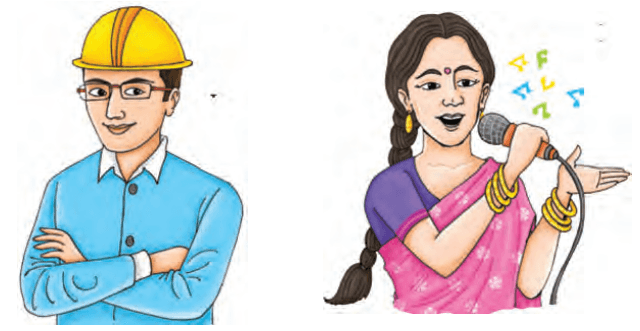
| Ravi | Mohini |
1. A portrait or a picture of a handsome young man in full sleeves shirt. 2. Raavi is an engineer in a manufacturing firm. 3. He likes to make, fix, and repair things. 4. He loves to watch television and goes to the movies thrice a month. 5. He is congenial and supportive. 6.He does not like to play, but goes for a morning walk every day.
| 1. A portrait or a picture of a middle-aged lady who is a singer. 2. She studied music and became a playback singer. 3. She likes to be with people and participates in social functions. 4. She loves music and reading books. 5. She is firm and a lady with a purpose. 6. She does not get time to exercise.
|
Now, write a description of any one of the above based on the details given. You may follow the process approach to writing. First, you read the given information in the box and make a list of describable (adjectives) points used for each person, in your own words. Secondly, take the help of these points to develop an outline in sentence form. Thirdly, use the outline and prepare the first draft of the description of the person and then edit the draft. Prepare the final copy after making all changes. The table below gives your ideas on how the Process Approach is helpful for improving your writing.
| Writing: The Process Approach | |
| The processes | What do you do? |
| Brainstorming | Note down as many ideas as you can about a given topic. Then arrange the ideas in a sequence. |
| Outlining | Create an outline of your writing— which ideas will go first, how will they be supported by evidence, will there be a picture, etc. |
| Drafting | Write the first draft; here the focus is on the content and not the form. |
| Revising | Revise the first draft, improve it. Add or delete ideas and improve the language. |
| Proofreading | Proofread the draft with the help of the teacher; here the focus is on the form and not the content. |
| Final draft | Write the final draft now. |
Ravi\ Mohini __________________________________________________________________________________ __________________________________________________________________________________ |
Ans 2: Here’s a short portrait/description of Mohini:
First Draft:
Mohini is a middle-aged lady with a passion for music. She studied music professionally and became a playback singer. She enjoys socializing and actively participates in community events. Her love for music is matched by her interest in reading books. Mohini is a determined woman with clear goals. Due to her busy schedule, she struggles to find time for exercise.
Revised Version:
Mohini is an accomplished middle-aged playback singer with a graceful presence. Having formally studied music, she has turned her passion into a successful career. She is a sociable person who enjoys attending and performing at social gatherings. When not singing, Mohini immerses herself in books, showing her intellectual curiosity. She carries herself with purpose and determination, qualities that have helped her excel in the competitive music industry. The only thing she wishes she could change is finding more time for physical exercise amidst her demanding routine.
Final Draft:Mohini: The Passionate SongbirdMohini is a graceful, middle-aged playback singer whose voice has charmed countless listeners. With formal training in classical music, she has established herself as a respected artist in the industry. Extroverted by nature, Mohini thrives in social settings and is often the life of gatherings. Her calendar remains full with musical performances at weddings, festivals and cultural events. When not performing, this multifaceted artist can be found absorbed in books, ranging from poetry to philosophy. What truly sets Mohini apart is her unwavering determination. Colleagues describe her as a woman of quiet strength who pursues her goals with single-minded focus. While she regrets not being able to maintain a regular exercise regimen, she makes up for it by walking to nearby studios instead of driving. Her journey from music student to established singer reflects both her talent and strong work ethic. Mohini continues to inspire younger artists through her dedication to the art form she loves. Key Adjectives Used: graceful, respected, extroverted, multifaceted, unwavering, determined, inspired |
Project
Q 1. You may have come across some people in your neighborhood who might have inspired you with their actions. Talk to them about—
- their childhood, their education, job, their likes and dislikes
- their contribution to the enrichment of their village or town, job, country, etc.
- their interesting features and characteristics
Request for their pictures. Based on the collected information, write their portraits and present it to the class. You may read on ‘How to do project work?’ given below.
How to do project work in the English language classroom? In addition to the textbook activities, project work could be used as an effective strategy to promote collaborative ways of language learning where we work together in groups to do an activity. We collect information, ideas; observe the language being used; use language in real life situations; exchange views and debate on ideas; write the ideas into a report; edit our writing and produce the report in a suitable form. This helps in constructing ideas and analysing critical judgments of the peers to arrive at a decision or conclusion. It would be of much benefit to learners, if projects planned are of an interdisciplinary nature. Designing and managing projects There are many ways students can be initiated to carry out projects. • Read books, newspapers, listen to the radio, watch TV, consult websites and encyclopedia, talk to people, observe events and proceedings, interview people, record audio/ video, collect pictures and illustrations, interpret them, and report. • Write field notes to remember and organise the data collected. • Bring your own ideas to the class and have a class discussion. • Use language meaningfully and precisely. If the meaning of learning is ‘meaning making’, the purpose is achieved fully while doing projects. • Learners should do the projects in group independently. They should not ask their parents to do these or buy readymade products available in the market. • They may seek information or some help from parents or elders. Planning, writing the draft and editing Having collected the required data, information and ideas, plan and organise the data and interpret them to write the draft. It could be posters, a script of a play (enact and direct a play), songs, essays, etc. Editing is an important part of writing the report. Students should be made aware of process approach involved in writing a good piece of work. Then present it to the whole class or to the school during the assembly or on special occasions (in case of play, songs, etc.). |
Ans 1: That sounds like a wonderful project! Based on your question and the guidelines for doing project work, here’s a sample portrait write-up of a person from your neighborhood. You can use this as a model to prepare your own report after interviewing someone inspiring from your community.
Portrait of an Inspiring Person in My Neighborhood
Name: Mr. Ramesh Verma
Occupation: Retired Teacher and Social Worker
Location: Greenview Colony, Sector 4
Childhood and Education:
Mr. Ramesh Verma was born in a small village in Uttar Pradesh. His childhood was full of challenges—he had to walk 5 kilometers every day to attend school. He was always a curious learner, and his love for books started at an early age. He completed his graduation in English Literature and later earned a B.Ed. degree.
Career and Contribution
He served as a high school English teacher for over 35 years. During his career, he not only taught but also inspired students to dream big. After retirement, he started free evening classes for underprivileged children in the locality. His contribution has helped many children pass board exams with good grades.
He also led several cleanliness drives, planted trees in the local park, and organized health awareness camps in the area. His dedication has made a visible impact on the environment and well-being of people in our neighborhood.
Likes and Dislikes
Mr. Verma loves reading books, especially biographies and historical novels. He enjoys gardening and often says, “Plants are silent teachers of patience.” He dislikes laziness and people who waste food.
Interesting Features and Personality
What makes Mr. Verma special is his calm and kind nature. He listens patiently and always motivates others to improve. His simple lifestyle, soft-spoken words, and tireless service make him a true role model.
Tips for Creating Your Own Project:
- Choose a person who has made a positive difference.
- Prepare a list of questions before the interview (about their childhood, education, job, achievements, likes/dislikes, etc.).
- Politely ask for a photo or draw a picture of them.
- Work in a group and divide tasks: one can interview, one can write, one can draw/poster.
- Revise and edit your work before presenting it.
Unit 1 – A letter to God Question Answer for class 10 English
Updated Solution 2024-2025
This complete solution is prepared as per the latest syllabus of 2024-25. If you have any further queries, feel free to ask! 😊

